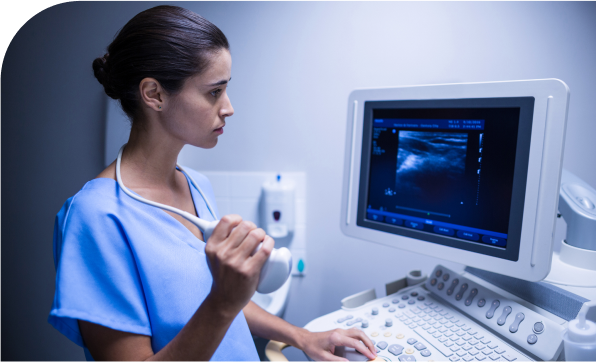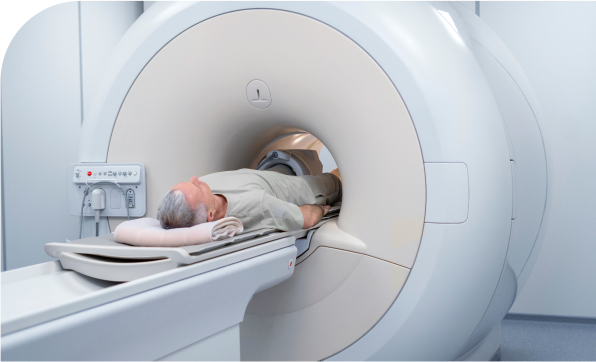

With extensive training and experience, we are dedicated to providing compassionate care and personalised ovarian cancer treatment in Mumbai, ensuring that each patient receives the best possible support tailored to their unique needs.

The ovaries are part of a woman’s reproductive system. They are in the lower part of the body below the umbilicus area (pelvis). Each ovary is about the size of an almond.

An ovarian cyst may be found on the surface of an ovary or inside it. A cyst contains fluid. Sometimes it contains solid tissue too. Most ovarian cysts are benign (not cancer). Most ovarian cysts go away with time.
Sometimes, a doctor will find a cyst that does not go away or that gets larger or it shows some solid components that may raise a suspicion of cancer. The doctor may order tests to make sure that the cyst is not cancer.

Doctors cannot always explain why one woman develops ovarian cancer and another does not. However, women with certain risk factors may be more likely than others to develop ovarian cancer.
Having a risk factor does not mean that a woman will get ovarian cancer.
Most women who have risk factors do not get ovarian cancer. On the other hand, women who do get the disease often have no known risk factors, except for growing older.
Risk factors, however, do not reveal everything. A person’s likelihood of contracting the disease is not necessarily determined by the presence of one or more risk factors. Additionally, many individuals who contract the disease may not have any known risk factors.


As the cancer grows, the abdomen can become bigger. This is due to the cancer or a build-up of fluid called ascites, which is caused by the cancer. Women may also lose weight in spite of having a bigger abdomen.
If you have not been diagnosed with ovarian cancer and are just looking through this site, please be aware that many of these symptoms occur without any serious disease being present. However, if you have any of the symptoms for more than two weeks, see your doctor for a check-up.

Symptoms may include persistent abdominal discomfort, bloating, or a feeling of pressure, which can indicate ovarian cancer and should be evaluated by a healthcare provider.

There may be a change in bowel habits and flatulence (wind). Irregular bowel patterns & persistent flatulence may indicate underlying physiological changes associated with ovarian cancer development.

Indigestion issues combined with frequent urination or changes in bowel habits can be signs of ovarian cancer, necessitating medical assessment for proper diagnosis.

Abnormal vaginal bleeding, especially post-menopause or between periods, can be a symptom of ovarian cancer and requires medical evaluation for further investigation.

Occasional pelvic or abdominal pain, coupled with other symptoms like bloating or difficulty eating, may indicate ovarian cancer and should be checked by a healthcare provider.

Ovarian cancer is sometimes discovered unexpectedly during routine pelvic exams or imaging tests for other conditions, emphasizing the importance of regular health screenings.

Years of experience in treating cancer patients and conducting clinical trials have helped doctors determine the most effective approaches for each type and stage of cancer. If you’re seeking ovarian cancer treatment in Mumbai, you will receive personalised care based on the type, stage, and spread of the cancer, as well as your overall health, ensuring the best possible outcome.
If you have a symptom that suggests ovarian cancer, your doctor must find out whether it is due to cancer or to some other cause. Your doctor may ask about your personal and family medical history.
This section lists common tests. It is not necessary for all the tests to be performed and your doctor will select the tests that will provide maximum information about the tumor/ disease.
You may have one or more of the following tests.
Your doctor may order blood tests. The lab may check the level of several substances, including CA-125. CA-125 is a substance found on the surface of ovarian cancer cells and on some normal tissues. A high CA-125 level could be a sign of cancer, however, the CA-125 test is not used alone to diagnose ovarian cancer.

Ultrasound scans are very important in the diagnosis of ovarian cancer.
They are done in two ways. In an abdominal scan, the ultrasound specialist passes a hand-held device called a transducer over your pelvic area. This is used to build up pictures of your organs. The pictures can be seen on a screen.
Sometimes the ovaries may not be seen well by an abdominal ultrasound and the device may be inserted into the vagina (transvaginal ultrasound) for a better view of the ovaries.

A CT scan is a type of x-ray that gives a picture of organs and other structures (including any tumours) in your body. It is used to see more details of a cancer and its relation to the surrounding organs in your body.
It also gives information related to cancer spread into the lymph nodes, liver or lungs.

Your doctor checks general signs of health. Your doctor may press on your abdomen to check for tumors or an abnormal build up of fluid (ascites). A sample of fluid can be taken to look for ovarian cancer cells.

This test is combined with a CT scan by injecting a radioactive material in the body to highlight all areas where the tumor has or can spread. This test may be used to build up more information after an MRI or CT scan. PET scan is not necessary for all patients. Your doctor will decide if you need to undergo this scan.

A biopsy is the removal of tissue or fluid to look for cancer cells. Based on the results of the blood tests and ultrasound/ CT scan, your doctor may suggest open surgery (a laparotomy) to remove tissue and fluid from the pelvis and abdomen.
Surgery is usually needed to diagnose ovarian cancer. Although most women have a open surgery for diagnosis, some women have a procedure known as laparoscopy. The doctor inserts a thin, lighted tube (a laparoscope) through a small incision in the abdomen.

This test is like a CT scan, but it uses magnetism instead of x-rays to build up pictures of the organs in your abdomen. Like a CT scan, MRI is painless and the magnetism is harmless.
MRI scan may be more informative in cases of low rectal cancers.

Your doctor feels the ovaries and nearby organs for lumps or other changes in their shape or size.
During a pelvic examination, a healthcare provider visually and manually examines the reproductive organs, including the ovaries, uterus, cervix, and vagina, to check for any abnormalities such as tumors, cysts, or other concerning signs. However, this examination alone cannot treat ovarian cancer. If abnormalities are found, further diagnostic tests such as imaging studies (like ultrasound or MRI) and blood tests (such as CA-125 levels) are typically performed to confirm the diagnosis of ovarian cancer.


The type of surgery you have depends on the stage of your cancer. But you are most likely to have your ovaries, fallopian tubes and womb removed. This is called a ‘total abdominal hysterectomy’ and ‘bilateral salpingo-oophorectomy’. You may hear your doctor call this operation TAH and BSO, for short. The surgeon will also remove a sheet of tissue from inside the abdomen. This tissue is called the omentum, so this part of the operation is called an ‘omentectomy’.
If your surgeon thinks it is possible to remove all or most of your cancer, you will have surgery before your chemotherapy. But if it would be difficult for the surgeon to remove enough of the cancer, you may have chemotherapy first. Chemotherapy before surgery is called neo-adjuvant chemotherapy.
After an anaesthetic, the movement of the bowel slows down and usually takes about 72 hours to get back to normal. After about 48-72 hours you will probably be ready to start taking small sips of water, however your doctors will tell you when it is appropriate for you to start drinking some fluids. This will be gradually increased after a couple of days until you are able to eat a light diet.
You will probably be ready to go home in about 10-14 days after your operation and once your stitches have been removed. If deemed appropriate your doctor may send you home with stitches and call you later to remove the stitches. By and large you should be able to climb several flights of stairs after your discharge from the hospital and you will be given diet instructions.
Before you leave hospital you will be given an appointment for a post-operative check-up at the outpatient clinic.
There is no restriction on the type of food you eat after an ovarian surgery and you should be able to eat all that you did before surgery.


Dr. Deepak Chhabra is a consultant Surgical Oncologist with an extensive experience in cancer surgeries. He is has specialized in Hepato (Liver) -Biliary (Gallbladder) and Pancreatic Cancer Surgeries.

Take the first step towards your journey to wellness by scheduling an appointment with Dr. Deepak Chhabra, a trusted oncologist dedicated to providing compassionate care and personalized treatment plans.
Discover first hand accounts from patients who have experienced compassionate care and expert treatment at our clinic. Read their reviews to get to know their journey.
5 Out of 5 from 92 Reviews
